Field-Tested Setup Guide for Rifle Season Success – Shelter, Sleep, Cooking & Comfort Tips from 20+ Seasons
TESTED Updated November 2025
🦌 Quick Verdict: What You Really Need
Field-Tested by Michigan Hunters
This gear has been proven through 20+ Michigan rifle seasons in the UP and Northern Michigan
Essentials for Every Deer Camp: Quality shelter that keeps you warm and dry (wall tent or cabin), reliable sleeping system rated for November temperatures, efficient cooking setup, adequate lighting, and proper food storage.
These core elements separate miserable camps from memorable hunts. Michigan’s rifle season (November 15-30) brings unpredictable weather—be prepared for 15°F to 45°F temperature swings.
Budget-Tier Setup ($300-500): Basic wall tent, cots with sleeping bags, propane stove, LED lanterns, and coolers will get you through opening weekend comfortably. Perfect for first-time deer campers testing the waters.
Premium Setup ($1,500-3,000): Insulated canvas tent with wood stove, raised cots with premium sleeping bags, portable power station for electronics, quality coolers, camp kitchen setup, and comfort amenities. For serious hunters planning week-long camps or annual traditions.
Bottom Line: Don’t cheap out on shelter and sleep—cold, exhausted hunters miss opportunities. Invest in quality where it matters, but you don’t need every gadget. Focus on staying warm, dry, fed, and rested so you’re alert when that buck appears.
Michigan’s firearm deer season is sacred tradition for over 500,000 hunters annually, with rifle season (November 15-30) representing the most anticipated two weeks of the year. From the Upper Peninsula’s remote wilderness to the hardwood forests of Northern Michigan, deer camp is where friendships are forged, stories are told, and memories are made around crackling campfires.
But a successful deer camp requires more than enthusiasm—it demands the right deer camp essentials. Proper gear, smart planning, and knowledge passed down through generations separate comfortable, memorable hunts from miserable experiences. A week spent shivering in inadequate shelter or struggling with malfunctioning equipment wastes precious hunting time and ruins what should be unforgettable.
After decades of Michigan deer camps—from primitive tent setups in the UP to established cabin operations—we’ve identified the deer camp essentials that actually matter versus marketing gimmicks that collect dust. This comprehensive guide reveals what you genuinely need for a comfortable, efficient deer camp that keeps you focused on hunting rather than survival.
Whether you’re establishing your first deer camp or upgrading your longtime setup, this guide covers shelter systems, sleeping gear, cooking equipment, power solutions, and the often-overlooked essentials that separate veteran campers from shivering rookies. For detailed hunting equipment recommendations including rifles, optics, and tree stands, see our best deer hunting gear guide. For navigation and tracking solutions, check our best GPS watch test.
🦌 MICHIGAN RIFLE SEASON COUNTDOWN: 2 WEEKS
With opening day November 15th approaching, now’s the time to finalize your deer camp setup. This guide ensures you’re warm, organized, and ready to focus on hunting—not surviving.
Shelter Systems: Wall Tents vs Cabins vs RVs
The foundation of every successful deer camp starts with shelter. Your choice determines comfort level, setup time, and how many hunters you can accommodate.
| Shelter Type | Canvas Wall Tent | Hunting Cabin | Travel Trailer/RV |
|---|---|---|---|
| Initial Cost | $400-1,200 | $5,000-50,000+ | $15,000-60,000 |
| Setup Time | 2-4 hours (first time) | None (permanent) | 15-30 minutes |
| Capacity | 4-12 hunters | 4-20+ hunters | 2-8 hunters |
| Weather Protection | Excellent (with stove) | Superior | Superior |
| Heating Method | Wood stove (free fuel) | Wood/propane/electric | Propane/electric |
| Mobility | Relocate anywhere | Fixed location | Relocate (vehicle req’d) |
| Insulation | Good (canvas breathes) | Excellent | Excellent |
| Standing Room | Yes (center peak) | Yes (full height) | Yes (full height) |
| Maintenance | Moderate (canvas care) | High (year-round) | Low (seasonal) |
| Lifespan | 10-20 years | 50+ years | 15-25 years |
| Best For | Flexibility + tradition | Permanent setup | Comfort + convenience |
Note: Wall tents offer the best value for groups wanting authentic deer camp experience with flexibility to relocate. Cabins provide superior comfort for established camps with land ownership. RVs excel for hunters prioritizing modern conveniences and quick setup.
The 5 Critical Deer Camp Essentials for Hunting Success
1. Shelter & Heating: Stay Warm or Go Home
Michigan’s November weather is notoriously unpredictable. Opening morning could be 15°F with snow squalls, or unseasonably warm at 50°F. Your shelter system must handle extremes while keeping hunters comfortable enough to wake before dawn and stay alert through long sits.
Canvas Wall Tents: The classic deer camp shelter for good reason. Quality 12oz or heavier canvas breathes to prevent condensation, sheds rain and snow effectively, and accommodates wood stoves safely. Look for tents with reinforced stress points, zippered doors and windows, and sewn-in floors to keep critters out.
Popular sizes: 10×12 (4-6 hunters), 12×14 (6-8 hunters), 14×16 (8-12 hunters). Wall height matters—6-7 foot walls allow standing room around the perimeter, critical for dressing and gear organization.
Wood Stoves for Tents: Essential for multi-day November camps. A properly installed tent stove transforms frigid mornings into cozy comfort. Choose stoves with 4-6 inch flue pipes, adjustable dampers, and flat cooking surfaces. Position stove centrally with adequate clearance from canvas walls (minimum 2 feet).
Firewood strategy: Pre-cut and split hardwood (oak, maple, beech) burns longer and hotter than softwoods. Budget 1/4 cord per week for continuous heating. Note: Michigan firewood transport restrictions exist to prevent emerald ash borer spread—source locally when possible.
Propane Heaters (Mr. Heater Buddy): For hunters without wood stove setups or quick warmth needs. The Mr. Heater Buddy (9,000 BTU) safely heats small spaces and connects to 20lb propane tanks with optional hose adapter. Critical safety note: Ensure adequate ventilation even with “indoor-safe” heaters to prevent carbon monoxide buildup.
Real-World Tip: Pack extra sleeping bags rated 10-15°F below expected lows. It’s easier to ventilate if too warm than shiver through sleepless nights. Cold hunters make poor shots and dangerous decisions.
2. Sleeping Systems: Quality Rest = Successful Hunts
Eight hours sitting motionless in a tree stand demands quality rest the night before. Inadequate sleeping systems leave hunters exhausted, cold, and prone to dozing off during prime movement hours.
Cots vs Ground Pads: Raised cots keep you off cold ground, provide under-bunk storage, and make getting up at 4 AM significantly easier on aging backs. Look for cots rated 300+ lbs with sturdy frames and tight fabric that won’t sag. Coleman and Teton Sports make reliable options under $100.
Ground pads work for younger hunters or those packing light, but November ground temperatures (often below freezing) require thick closed-cell foam pads with R-values of 5+. Inflatable pads provide comfort but risk punctures—bring patch kits.
Sleeping Bags for November Michigan: Temperature ratings confuse many hunters. Manufacturers’ “comfort ratings” assume you’re wearing base layers in a sheltered tent. For November deer camp:
• 0°F to 15°F bags: Necessary for unheated tents or cold snaps
• 15°F to 30°F bags: Adequate with tent heaters or mild conditions
• 30°F+ bags: Only sufficient for heated cabins or RVs
Down vs synthetic fill: Down provides better warmth-to-weight ratio but loses insulation when wet. Synthetic bags maintain warmth when damp and cost less, making them ideal for deer camp where moisture and spills happen. Top budget option: Teton Sports Celsius rated to 0°F ($80-120).
Pillows and Extras: Don’t skip pillows—compressible camping pillows or stuff sacks filled with extra clothes work fine. Foam earplugs are essential if hunting with snorers (every camp has at least one). Sleeping bag liners add 5-15°F warmth and keep bags cleaner.
Real-World Tip: Designate one person as the “fire tender” each night on rotation. Keeping a wood stove burning through early morning hours means everyone wakes to warmth instead of frozen water bottles and stiff joints.
3. Cooking & Food Storage: Fuel for Long Sits
Hunting burns 2,500-4,000 calories daily depending on terrain and weather. Inadequate food or complicated cooking wastes hunting time and leaves hunters sluggish. The best deer camp kitchens balance nutrition, efficiency, and tradition.
Camp Stoves: Two-burner propane stoves (Coleman Guide Series, Camp Chef) provide adequate cooking power for groups up to 8 hunters. Three-burner setups handle larger camps efficiently. Budget 1lb propane bottle per burner per day, or bring 20lb tanks with adapter hoses for week-long camps.
Cast iron skillets and Dutch ovens cook over wood stoves or open fires, adding authentic flavor to deer camp meals. Pre-season cast iron properly to prevent sticking and rust.
Coolers and Food Storage: Premium coolers (Yeti, RTIC, Pelican) maintain ice 5-7 days in November temperatures, critical when camps lack refrigeration. Budget option: Foam-insulated coolers work adequately for 2-3 day trips if you avoid opening them frequently.
Cooler strategy: Use one cooler exclusively for beverages (opened frequently), one for perishable food (opened minimally), and one for processed venison. Block ice lasts significantly longer than cubed ice—freeze gallon milk jugs for DIY block ice.
Meal Planning Essentials: Breakfast: Bacon, eggs, potatoes, coffee (lots of coffee). Lunch: Sandwiches, soup, hot dogs. Dinner: Chili, stew, venison steaks, pasta. Keep it simple—elaborate meals waste hunting time.
Non-perishable staples: Coffee, sugar, salt, pepper, hot sauce, bread, peanut butter, canned soup, crackers, trail mix, beef jerky, candy bars (emergency energy). Don’t forget cooking oil, butter, aluminum foil, and paper towels.
Real-World Tip: Pre-cook chili, stew, or soup at home and freeze in gallon Ziploc bags. They act as additional ice in coolers during transport, then thaw for easy reheating at camp—minimal cook time, maximum flavor. For power needs at remote camps, consider our tested best power banks for backpacking.
4. Lighting & Power: See After Dark
November days are short—sunrise around 7:30 AM, sunset by 5:30 PM. Deer camp requires adequate lighting for pre-dawn preparation, evening cleaning, card games, and navigating safely between tent and outhouse.
LED Lanterns: Modern LED lanterns provide 500-1000 lumens of bright, white light running 10+ hours on D batteries or rechargeable packs. Hang lanterns from tent ceiling hooks for ambient lighting. Popular options: Coleman BatteryGuard 800L ($35), Goal Zero Lighthouse 600 ($70), Lepro collapsible 4-pack ($35).
Lighting strategy: One lantern per 4 hunters for general camp lighting, plus individual headlamps for each person. String lights add atmosphere but drain batteries quickly—save for special occasions.
Headlamps: Hands-free lighting is essential for field dressing, tracking blood trails, and navigating dark woods. Look for 200+ lumen output with red light modes to preserve night vision. Budget option: Energizer Vision HD ($20). Premium: Petzl Actik Core ($70).
Portable Power Stations: Game-changers for modern deer camps. Units like Jackery Explorer 1000 or Bluetti AC180 power lights, charge phones/GPS units, run 12V fridges, and even operate electric heaters for a few hours. This eliminates noisy generators and provides reliable power for week-long camps.
A 1000Wh portable power station runs LED lanterns for 30+ hours, charges 50+ phone cycles, and powers a 12V cooler for days. Pair with portable solar panels to recharge during daylight. For comprehensive comparisons, see our Jackery vs Bluetti power station guide.
Real-World Tip: Bring spare batteries for everything—double what you think you’ll need. Cold temperatures drain batteries faster, and Murphy’s Law guarantees critical gear fails at the worst moment. AA and D batteries are camp essentials.
5. Comfort & Convenience: Small Things Matter
The difference between tolerable deer camp and memorable deer camp often comes down to seemingly minor comfort items that veterans pack religiously.
Seating: After 8-10 hours in tree stands, your back needs proper support. Folding camp chairs with armrests and cup holders provide civilized evening comfort around the fire or tent stove. Coleman Oversized Quad chairs support 300+ lbs and pack relatively flat.
Tables: Folding camp tables (4-6 foot) provide proper surfaces for food prep, card games, and cleaning gear. Avoid eating off coolers or ground—it’s unsanitary and miserable.
Hygiene Essentials: Portable toilet or designated outhouse location (dig cathole minimum 200 feet from camp/water sources). Toilet paper in waterproof container, hand sanitizer, biodegradable soap, paper towels. Baby wipes are luxuries that maintain sanity during week-long camps.
Entertainment: Playing cards, dice, cribbage board. Long November evenings invite storytelling and friendly competition. Some camps bring portable speakers for music, but respect traditional camps preferring natural quiet.
Organization: Plastic totes or duffel bags for each hunter’s personal gear prevents chaos. Hooks or rope lines for hanging wet clothes and orange vests. Tarp for muddy boots outside tent entrance.
Real-World Tip: Designate camp roles—cook, fire tender, water hauler, cleanup crew. Rotating responsibilities prevents resentment and keeps camp running smoothly. The guy who shoots the biggest buck cooks victory dinner tradition builds camaraderie.
Complete Deer Camp Essentials Checklist: Everything You Need
Comprehensive gear list organized by category and priority level for Michigan November rifle season camps.
| Category | Essential Items | Recommended Items | Luxury/Optional Items |
|---|---|---|---|
| Shelter & Heating | Wall tent or cabin access, Wood stove or propane heater, Firewood/propane, Fire extinguisher, Carbon monoxide detector | Extra tarps, Tent repair kit, Spare stove parts, Axe and saw for firewood | Generator, Portable power station, Solar panels, Electric heater backup |
| Sleeping | Cot or sleeping pad, 0-15°F sleeping bag, Pillow, Earplugs | Sleeping bag liner, Extra blankets, Cot pad/mattress topper | Memory foam pad, Heated mattress pad, Premium sleeping bag |
| Cooking | 2-burner stove, Propane tanks, Cast iron skillet, Pot for boiling water, Eating utensils, Plates/bowls, Coffee pot, Can opener, Knife | Dutch oven, Griddle, Cutting board, Dish tub, Dish soap, Sponge, Dish towels | 3-burner stove, Camp oven, Espresso maker, Spice kit |
| Food Storage | 2-3 coolers (100qt+), Ice or ice packs, Food bins, Trash bags | Premium cooler (Yeti/RTIC), Dry food storage bins, Bear-proof container (UP) | 12V electric cooler, Portable freezer, Collapsible sink |
| Lighting | LED lanterns (2-3), Headlamps (one per hunter), Extra batteries (AA, D), Flashlights | String lights, Rechargeable lanterns, Red light headlamps, Backup headlamp | Portable power station, Solar charger, LED rope lights |
| Furniture | Folding chairs (one per hunter), 6-foot folding table | Extra chairs, Small side table, Bench seating | Hammock, Portable recliner, Gear organizer shelves |
| Hygiene | Toilet paper, Hand sanitizer, Paper towels, Trash bags, Biodegradable soap | Portable toilet, Baby wipes, Camp shower, Towels, Toothbrush/toothpaste | Propane water heater, Privacy tent/shower, Solar shower bag |
| Safety & First Aid | First aid kit, Prescription meds, Pain reliever, Fire extinguisher, Emergency whistle, Cell phone | Two-way radios, GPS device, Emergency blanket, Duct tape, Paracord | Satellite communicator (inReach), Comprehensive trauma kit |
| Tools & Repair | Multi-tool, Duct tape, Rope/paracord, Zip ties, Bungee cords, Folding saw | Hatchet/axe, Hammer, Screwdriver set, Pliers, Work gloves | Chainsaw, Portable tool kit, Extra fuel cans, Generator |
| Clothing Storage | Plastic totes per hunter, Hanging hooks/rope line, Boot mat/tarp | Laundry bag, Scent-free storage bags, Gear drying rack, Camo clothing care | Boot dryer, Heated gear storage, Waterproof gear bags |
| Entertainment | Playing cards, Dice, Books/magazines | Cribbage board, Portable speaker, Hunting stories book | Portable TV/DVD player, Board games, Projector |
| Miscellaneous | 5-gallon water jugs, Matches/lighters, Aluminum foil, Plastic bags, Permanent marker | Water filtration, Extra batteries for everything, Notebook/pen, Camera, Trail cameras for scouting | Propane fire pit, Outdoor rug, Flag pole, Walkie-talkies |
Packing Tip: Create your checklist 2-3 weeks before season, then shop for missing items early. Don’t wait until November 14th when stores sell out of critical gear. Print this table and check off items as you pack. For comprehensive safety equipment recommendations beyond basic first aid, see our hunting safety gear guide.
What’s Your Deer Camp Setup?
Share your Michigan deer camp experiences in the comments below!
Shop Top-Rated Deer Camp Gear
Essential equipment tested and recommended by experienced hunters
Recommended Setups by Camp Type & Budget
🎯 Weekend Warrior Camp
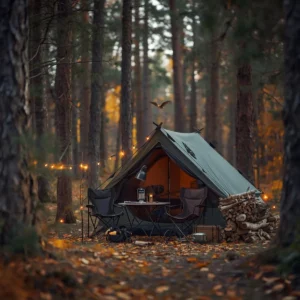
🏕️ Week-Long Traditional Camp
🔋 Modern Power Camp
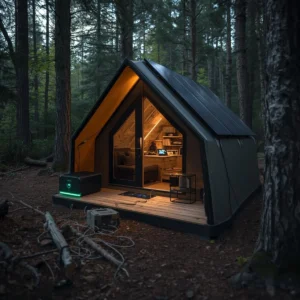
🏡 Cabin or RV Camp
🎒 Minimalist Backcountry Camp
🦌 Large Group Camp

Essential Michigan Hunting Resources
Successful and legal deer hunting in Michigan requires understanding current regulations, season dates, and safety requirements.
These official resources provide crucial information:
- Michigan DNR: Hunting Regulations & Seasons
Official Michigan Department of Natural Resources hunting information including season dates, licensing requirements, deer management unit regulations, and harvest reporting requirements for all hunting seasons. - National Park Service: Hunting Safety Guidelines
Federal hunting safety standards and best practices for firearm handling, tree stand safety, wilderness preparation, and emergency response protocols applicable to all hunters nationwide.
Deer Camp FAQs: Your Questions Answered
What’s the minimum gear needed for a basic deer camp?
Absolute essentials: Shelter (tent/cabin), sleeping bag rated for November temperatures, sleeping pad or cot, propane stove, cooler with ice, LED lanterns, warm clothing layers, hunter orange, hunting license, and firearm with ammunition. This basic setup costs $300-500 and handles weekend trips adequately. Add wood stove or heater for week-long comfort.
How much firewood do I need for a week-long deer camp?
Plan for 1/4 to 1/2 cord of split hardwood (oak, maple, beech) per week for continuous tent stove heating in November. That’s roughly one pickup truck load of split wood. Cold snaps require more—better to have excess than run out at 3 AM. Source firewood locally in Michigan to comply with emerald ash borer transport restrictions. Pre-split wood saves time and energy at camp.
What sleeping bag temperature rating do I need for Michigan rifle season?
For unheated tents: 0°F to 15°F rated bags handle November’s unpredictable weather (historical range: 5°F to 50°F). For heated tents with wood stoves: 15°F to 30°F bags suffice. For heated cabins or RVs: 30°F+ bags work fine. Always choose bags rated 10-15°F colder than expected lows—it’s easier to ventilate than shiver. Synthetic fill outperforms down in damp conditions common at deer camp.
Should I get a portable power station for deer camp?
Yes, if your camp relies on electronics (phones, GPS, lights, radios) or you want to avoid noisy generators. A 1000Wh portable power station runs LED lanterns for 30+ hours, charges 50+ phones, powers 12V coolers for days, and operates small heaters briefly. Pair with solar panels for week-long independence. Budget $400-600 for quality units (Jackery, Bluetti, Anker). Skip if you’re going primitive or have cabin electricity.
What size wall tent do I need for my group?
Plan 30-40 square feet per hunter minimum for comfortable sleeping and gear storage. Recommended sizes: 10×12 (4-6 hunters), 12×14 (6-8 hunters), 14×16 (8-10 hunters), 16×20 (10-14 hunters). Larger tents accommodate wood stoves centrally with safe clearances. Wall height matters—6-7 foot walls allow standing room around perimeter. Canvas weight: 12oz minimum, 15oz for cold weather durability.
How do I keep food cold for a week without electricity?
Use premium coolers (Yeti, RTIC, Pelican) with block ice—maintains 5-7 days in November. Strategy: Use separate coolers for beverages (opened frequently) and food (opened minimally). Pre-chill coolers with ice overnight before packing. Freeze water in gallon milk jugs for long-lasting block ice. Keep coolers in shade, covered with blankets. Avoid opening during peak heat. Budget option: Standard coolers work for 2-3 days with proper ice management.
What’s safer—propane heaters or wood stoves in tents?
Both are safe when used properly; both are dangerous when misused. Wood stoves: Require proper installation with heat shields, adequate clearances (2+ feet from canvas), and spark arrestors on flue pipes. Propane heaters: Need ventilation even when rated “indoor safe” to prevent carbon monoxide buildup. Install CO detectors regardless of heat source ($20-30). Never use open-flame heaters (coleman lanterns) for tent heating—carbon monoxide poisoning kills hunters annually.
Can I use my summer camping gear for November deer camp?
Partially. Summer tents, sleeping bags rated above 30°F, and lightweight sleeping pads are inadequate for November Michigan. You’ll freeze. Reusable gear: camp stove, coolers, chairs, tables, cooking supplies, lanterns. Essential upgrades: 4-season tent or wall tent, 0-15°F sleeping bags, insulated sleeping pads, proper winter clothing layers, and reliable heat source. Don’t risk hypothermia trying to save $200 on proper gear.
How early should I arrive to set up deer camp?
First-time wall tent setup: Arrive 2-3 days before opener to properly position tent, install wood stove, organize gear, gather firewood, and troubleshoot issues. Experienced camps: 1 day before suffices. Consider “camp prep weekend” the weekend before rifle season for group setup, scouting, and camaraderie. Never wait until November 14th evening—stressed, rushed setup in dark leads to forgotten essentials and poor sleep before opener.
What’s the best cooler size for deer camp?
Minimum 100-150 quart capacity for week-long camps with 4-8 hunters. Plan multiple coolers: one for beverages (most access), one for food (minimal access), one for processed venison. Larger groups need 2-3 coolers minimum. Premium coolers (Yeti/RTIC) in 110qt size cost $300-400 but maintain ice week-long. Budget option: Coleman Xtreme 120qt ($50-80) works for 2-3 days with proper ice management and minimal opening.
OTL Bottom Line: Your Deer Camp Essentials Checklist
After decades of Michigan deer camps from primitive UP tent setups to established cabin operations, the formula for successful camps remains remarkably consistent: the right deer camp essentials make all the difference. Stay warm, sleep well, eat properly, and minimize hassles that waste hunting time.
The gear that genuinely matters centers on three priorities: shelter that handles November’s temperature swings and precipitation, sleeping systems that provide restorative rest after long sits, and efficient cooking/food storage that fuels hunters without elaborate preparation. Everything else—while adding comfort—ranks secondary to these fundamental deer camp essentials.
Budget-conscious first-timers can establish functional deer camps for $300-500 with basic wall tents, adequate sleeping bags, propane stoves, and standard coolers. This proves sufficient for testing whether deer camp culture suits your hunting style before investing in premium gear.
Serious hunters planning week-long annual traditions should budget $1,000-1,500 for quality wall tents with wood stoves, raised cots with premium sleeping bags, reliable cooking systems, and comfort amenities. This investment level creates deer camps hunters actually want to spend time in rather than merely tolerate.
Modern additions like portable power stations ($400-800) transform deer camps from rustic survival exercises into comfortable base camps while maintaining off-grid independence. Paired with solar panels, these systems provide reliable power for lights, device charging, and even electric coolers without generator noise that spooks deer and annoys neighbors.
The common mistakes we observe repeatedly: inadequate sleeping bags causing miserable cold nights, insufficient lighting making pre-dawn preparation chaotic, poor food planning wasting hunting time, and cluttered camps from lack of organization. All easily preventable with proper planning.
Michigan’s rifle season (November 15-30) represents two precious weeks when weather cooperates and deer movement peaks. Don’t waste these opportunities being cold, exhausted, or dealing with preventable gear failures. Invest in proper equipment, arrive early for calm setup, assign camp roles, and focus energy on hunting rather than surviving.
Whether you’re establishing your first deer camp or upgrading longtime setups, prioritize the big three—shelter, sleep, sustenance—and build from that foundation. The best deer camps balance tradition with practical comfort, creating environments where hunters want to return year after year regardless of whether tags get filled.
Ready to Build Your Deer Camp?
Michigan rifle season starts November 15th—don’t wait until the last minute to gather essential gear. Stock up now while availability is good and prices are competitive.
This guide was last updated in November 2025 for Michigan rifle deer season.
Field tested in Northern Michigan by Outdoor Tech Lab.
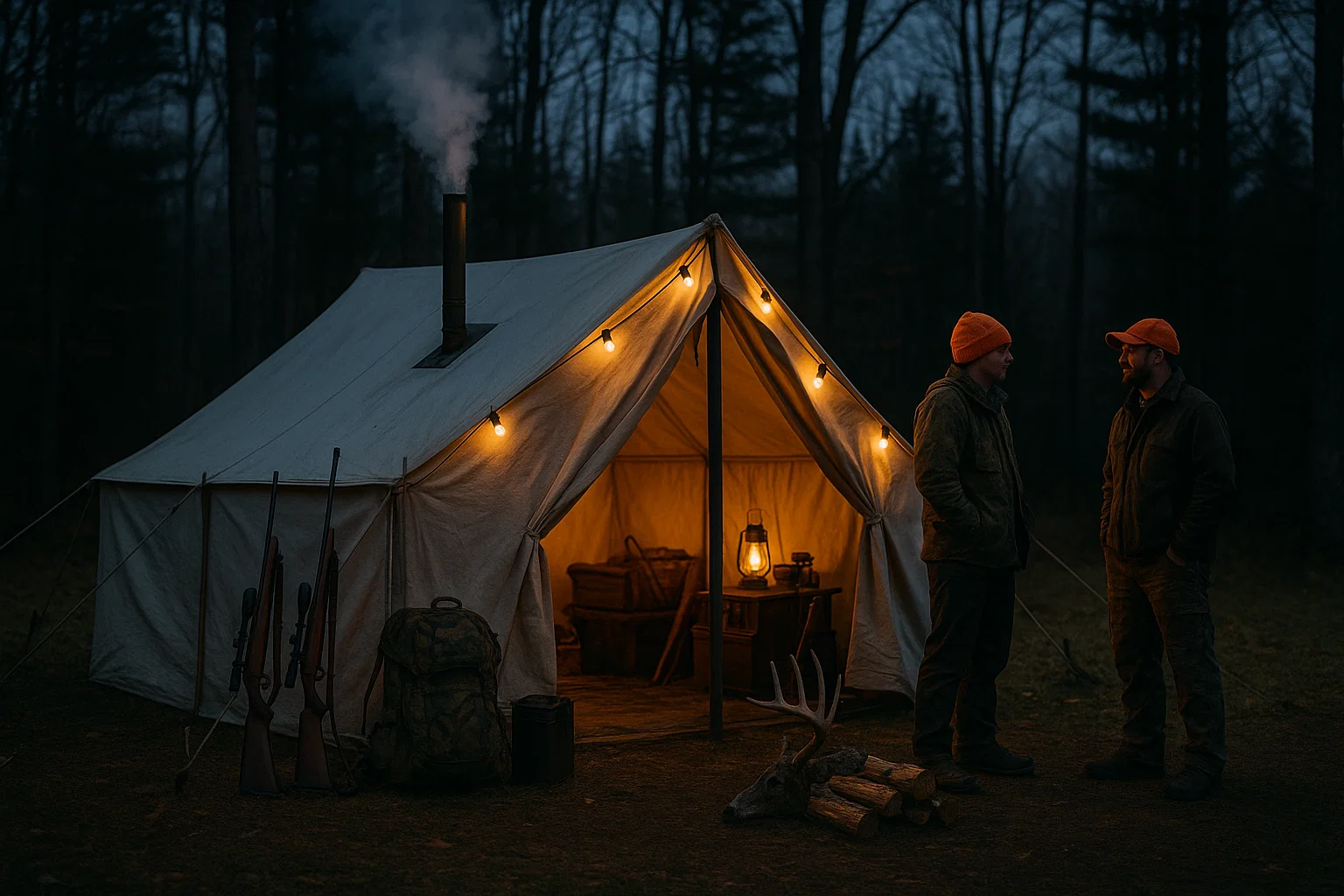
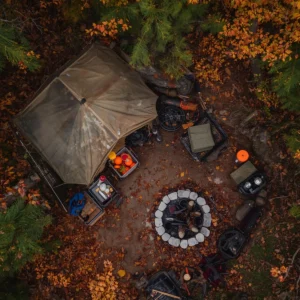
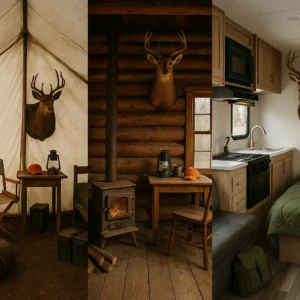
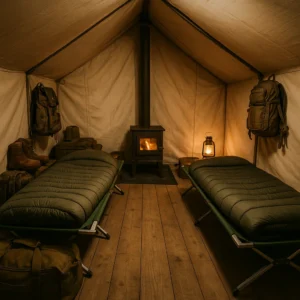
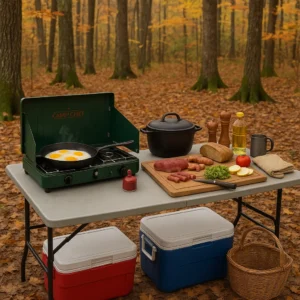
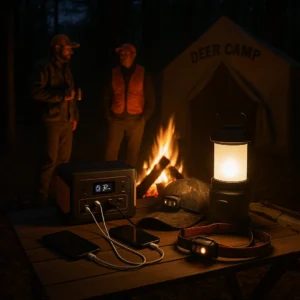


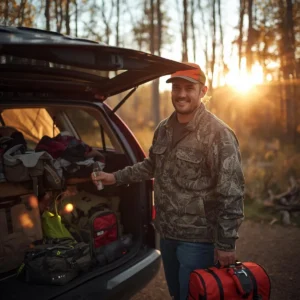



Leave a Reply